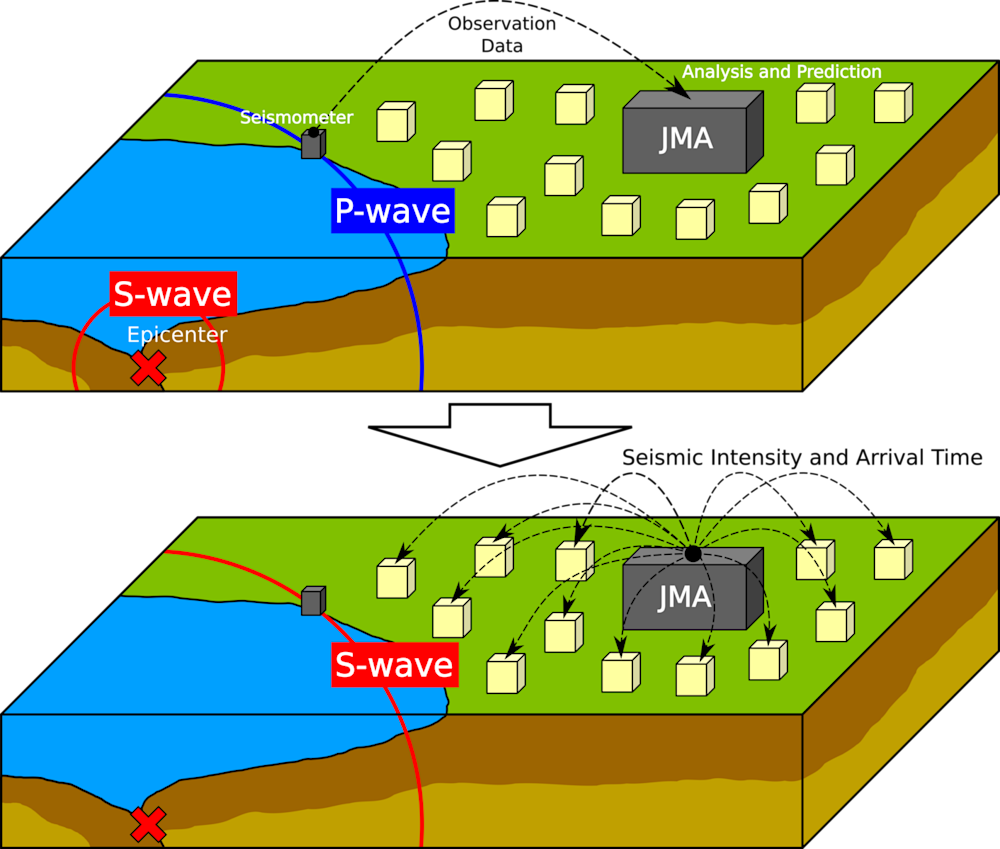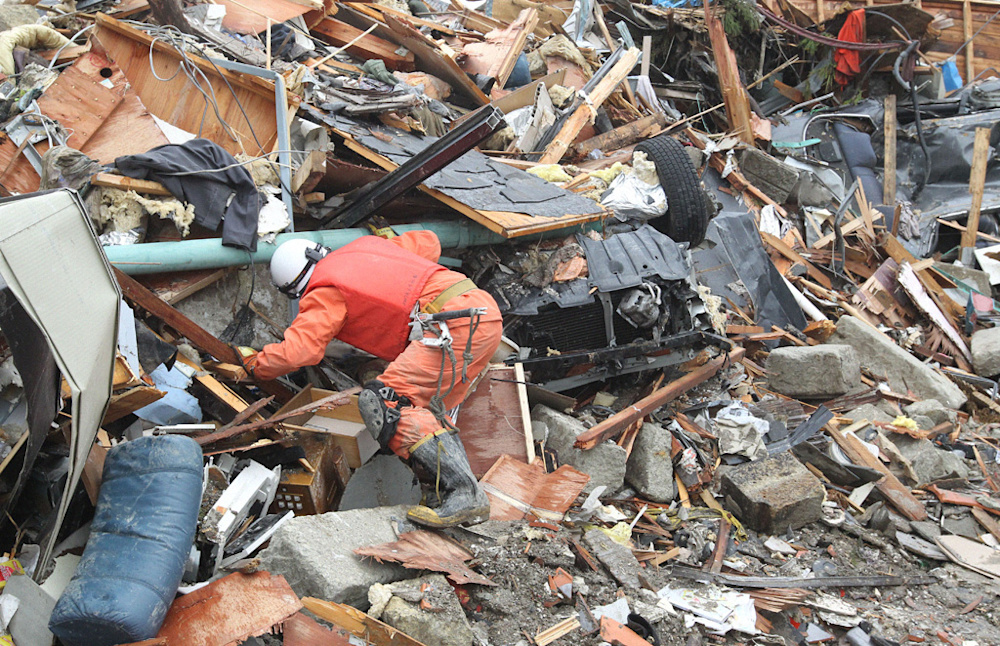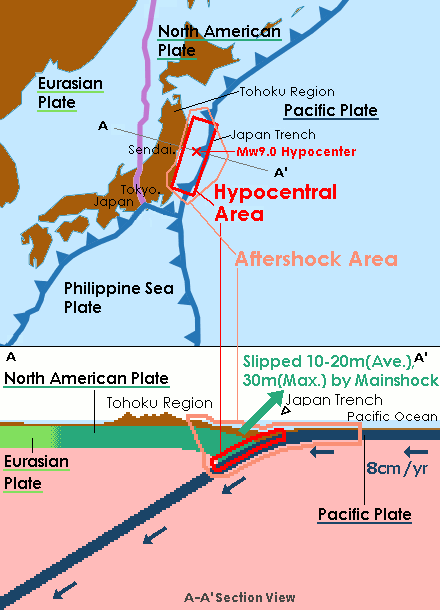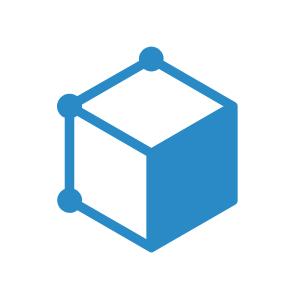Updated July 31, 2025
What To Do In An Earthquake in Japan—For Travelers & Residents
Is Japan safe from natural disasters? While Japan is generally safe and well-prepared, it is also one of the most earthquake-prone countries in the world.
Its building and infrastructure are designed with safety in mind, but knowing how to react is essential. Whether you’re visiting for a short time or living here long-term, here’s what to do when you experience an earthquake in Japan.
In this article: 📝
- Are earthquakes common in Japan?
- How to measure an earthquake in Japan
- Does Japan have an earthquake warning?
- Japan earthquake preparations
- What happens when there's an earthquake in Japan?
- What to do in Japan if there is an earthquake
- After an earthquake in Japan, be safe and act calmly.
- How to contact your family when there’s no signal during an earthquake
- Other resources: earthquakes in Japan and emergency apps
- In summary
Are earthquakes common in Japan?
Due to Japan’s unique location, it is part of an area called “The Pacific Ring of Fire.” Around here, many tectonic plates collide and shift against each other, causing volcanic activity and earthquakes.
More specifically, Japan is in conjunction with 4 major tectonic plates that are constantly moving:
Pacific Plate
Philippine Sea Plate
Eurasian Plate
North American Plate
As such, Japan has a long history of earthquakes dating back over 1,000 years. Some recent major ones include:
The Great Kanto Earthquake (1923): A magnitude 7.9 that devastated Tokyo and Yokohama with over 100,000 deaths.
The Kobe Earthquake (1995): A magnitude 6.9 earthquake that killed over 6,000 people and caused major damage.
The Great East Japan Earthquake (2011): A magnitude 9.0 earthquake that triggered a massive tsunami and nuclear disaster at Fukushima, causing over 15,000 deaths.
How to measure an earthquake in Japan
Japan measures earthquakes through the JMA Seismic Intensity Scale, also known as the Shindo Scale.
It is what the Japan Meteorological Agency (JMA) uses to measure how strong an earthquake is in different parts of Japan.
Unlike magnitude, where each increase is 32 times more powerful in energy release, the Shindo Scale measures the intensity of surface shaking, reflecting how people felt the quake and how much damage may occur.
The JMA Seismic Intensity Levels
The scale ranges from 0 to 7, with some levels having subdivisions:
Intensity |
Description |
0 |
Not felt by anyone |
1 |
Felt slightly by some people indoors |
2 |
Felt by many people indoors; hanging objects swing slightly |
3 |
Felt clearly indoors; light shaking |
4 |
Many people feel it; some may be frightened |
5- (Lower 5) |
Dishes may rattle; unstable items may fall |
5+ (Upper 5) |
People find it hard to walk; some furniture may move or fall |
6- (Lower 6) |
Difficult to stand; walls may crack; furniture may topple |
6+ (Upper 6) |
Almost impossible to stand; major risk of damage to weak buildings |
7 |
Severe shaking; many buildings may collapse; very destructive |
Does Japan have an earthquake warning?
Japan’s earthquake alert is called the Earthquake Early Warning (EEW) system.
This system will provide alerts to those in Japan just as an earthquake begins, giving them seconds to prepare before shaking occurs.
How does Japan’s earthquake alert work?
Japan has a dense seismometer network all over the country by the Japan Meteorological Agency (JMA) and other organizations.
Their sensors can detect the initial, less-damaging seismic waves (P-waves) that travel faster than the stronger shaking waves (S-waves).

A simplified image of how JMA detects an earthquake to give early warnings
As soon as the system detects P-waves, it will calculate the earthquake’s location, magnitude, and predicted shaking intensity in nearby areas.
If the prediction is strong enough to cause damage or danger, the JMA will issue an EEW alert through:
Mobile phones (via alerts)
Television and radio broadcasts
Public loudspeakers
Apps and internet services
This early warning will give people seconds to prepare to:
Take cover under a sturdy table or doorway
Stop any machinery or trains
Evacuate if needed
Prepare for emergency response
The JMA’S PDF about Early Earthquake Warning System has more details if you are interested.
Japan earthquake preparations
Secure your home by anchoring heavy furniture, appliances, and items that can fall and cause injury. You can use straps, braces, or tension rods to help things stay in place when shaking occurs.
Prepare an emergency kit, such as water, non-perishable food, flashlight, portable radio, batteries, first aid kit, and copies of important documents.
Locate your nearest evacuation area.
Download earthquake warning apps.
If possible, you should participate in evacuation drills at your work or at school to be familiar with the procedures.
What happens when there's an earthquake in Japan?

While small earthquakes are harmless, larger ones can cause severe shaking, damage to buildings and infrastructure that can disrupt your daily life and pose safety risks.
So understanding what might happen will help you prepare and respond accordingly.
Communication signals are down
A major earthquake can cause minor to major damage to transmission lines and communication towers, resulting in network disruption or total network failure.
As such, it makes it difficult for people to contact their family and friends.
Many communication carriers have strengthened their infrastructure for potential earthquakes and introduced disaster emergency message dial systems if another major earthquake were to occur.
Basic utilities are disrupted
When a major earthquake occurs in Japan, it can disrupt essential utilities such as electricity, gas, and water.
These services may be unavailable for several days, affecting everything from cooking and heating to charging devices.
Depending on the damage and your location, it can take hours to days for them to be restored.
If such a case were to happen, the local government can provide emergency water supplies and support, but having your own Japan emergency survival kit can help you stay self-sufficient and safe until help arrives.
Public transportation is down
There is a possibility of suspension or cancellation of trains, buses, and subways during and after an earthquake.
Depending on the damage, it can last for weeks to months.
Not only is it an inconvenience, but it can lead to smaller towns in Japan being cut off, making it difficult to evacuate or supply emergency relief.
Potential fire damage
Earthquakes can indirectly cause fire and explosions from power lines and gas pipelines. There is also a risk of a kitchen fire if the stove is on during an earthquake.
For example, the 1923 Great Kanto Earthquake caused many fires as people were cooking at the time.
Today, large-scale fire damage is less likely to occur due to stronger building materials, fewer wooden homes, better emergency services, and the widespread use of fire extinguishers.
But there is still a risk, which is why it is strongly advised to turn off your stove or any open flames immediately when you feel an earthquake.
This quick and small action will prevent something from becoming more dangerous.
What to do in Japan if there is an earthquake
An earthquake can happen anytime, anywhere. So it’s best to be prepared in any situation you might be in.
Here are a few situations where you might be in.
Outdoor and indoor
Whether you're indoors or outdoors during an earthquake, staying calm and knowing what to do can help keep you safe.
Here are some key safety precautions to follow.
Outdoors |
Indoors |
|
Stay calm and don’t panic. Move away from: Buildings (especially high-rises) Windows Hanging signs or power poles Protect your head with a bag or jacket. Follow instructions from station staff, police, or local officials. |
Take cover under a sturdy table or doorway. If not possible, protect your head with a pillow or jacket. Stay away from: Windows Bookshelves or hanging objects Turn off the stove to prevent fire (if safe to do so). Note: Gas lines can shut off automatically with strong quakes. Stay put until the shaking stops. If you need to evacuate, use stairs—not elevators—and exit calmly. |
In general, if you’re outdoors during an earthquake, move to an open space to avoid falling objects.
If you’re indoors, take cover under a sturdy table or desk to protect your head from falling debris.
When you are inside an elevator
If an earthquake happens when you’re in an elevator, press every floor button and get out when the door opens. Check the situation on that floor and take indoor actions to protect yourself.
If you are stuck in the elevator, press the “Emergency Call Button.” Follow the staff’s instructions during and after being rescued.
When you are on the train, including the Shinkansen
You may find yourself in any of these scenarios during an earthquake: on the train, at the train station, or in a Shinkansen. In all these situations, the EEW system will detect any seismic activity and alert train control systems to stop the train safely.
The next steps will vary. But always remember that all train and station staff have been trained for any emergency. So, remain calm and listen to their instructions.
What to do in an earthquake when on the train:
If standing, hold on to the straps or handrails, and watch out for falling objects.
If sitting, remain low and use your bag or arms to protect your head.
Watch out for overhead signs or lighting that may fall.
Listen to the train crew's instructions on what to do next when the shaking stops.
If it’s safe, the train may continue to the next station.
If not, evacuation may be necessary. Listen and follow the staff’s instructions.
What to do in an earthquake when at the train station:
Take cover and cover your head during an earthquake
After the shaking, remain calm.
Listen to the station staff and move toward the emergency exits.
After exiting, find designated evacuation areas, such as nearby parks or plazas
What to do in an earthquake while on the Shinkansen:
If the train’s onboard safety system triggers an emergency stop, it will slow the train as quickly and safely as possible.
Stay seated, fasten your seatbelt, and hold on to a stable surface.
If standing, crouch down and protect your head with your hand or bag.
When the Shinkasen stops, wait for instructions.
The train may continue to the next stop for passengers to exit.
If not, the staff will guide passengers in a controlled evacuation
Evacuate to higher ground, especially when you are at the beach
If you are at the beach, coastline, or near a river during a strong or long-lasting earthquake, you should immediately move to higher ground.
When an earthquake occurs near or under the ocean, it often triggers a tsunami, which can follow within minutes of the shaking. So, evacuate to higher ground without hesitation.
Continue reading for more information about earthquakes and tsunamis.
Earthquakes and tsunamis in Japan

A simplified explanation of the 2011 Tōhoku earthquake in Japan
A tsunami is a series of large ocean waves caused by sudden seafloor movement, usually from a powerful undersea earthquake.
These waves can travel fast and flood a wide area along the coast.

Be on the lookout for Japan tsunami warnings and evacuation shelter signs.
Here are some things to know about tsunamis and earthquakes:
Tsunamis can hit within minutes of an earthquake.
The first wave is not always the largest, but dangerous waves can continue for hours.
You may not always see warning signs, like the water pulling back.
Coastal rivers can also flood as tsunami waves move upstream.
So it’s always best to treat major earthquakes near the ocean as potential tsunami threats, even if you don’t see any water changes.
Earthquakes and landslides in Japan
In Japan’s mountainous or hilly areas, major earthquakes can trigger landslides or slope collapses.
This can happen because of the several active tectonic plates, making certain areas unstable after a quake.
So, if you’re in an area known for steep terrain or loose soil, there is a high risk of landslides.
In such cases, follow the local authorities' guidance and check if it's safe to evacuate, especially during or after heavy rain.
Check to see if your area is designated as a “Sediment Disaster Alert Area”.
After an earthquake in Japan, be safe and act calmly.
Even after the shaking, there could be aftershocks or tsunamis. So, it’s important to stay alert.
First, check yourself and those around you for any injuries. At the same time, check your surroundings for potential gas leaks, fire, broken glass, or exposed electrical wires.
If the building is unsafe or you’re advised to leave, then evacuate calmly and follow instructions from staff or local authorities.
Listen to the radio or watch the news, and follow official guidance closely for the latest updates and evacuation orders.
How to contact your family when there’s no signal during an earthquake
After a major earthquake in Japan, phone networks might be overloaded or down, making it hard to contact other family members.
Use the Disaster Emergency Message Dial (171) service to record or check safety messages by phone.
If you have internet service, you can also use Web171 or your mobile carrier’s disaster message board to post your status online.
Additionally, text messages and social media apps like LINE may work even when calls fail.
It’s always a good idea to have an agreed-upon meeting point or shelter in advance in case other forms of communication become difficult.
Other resources: earthquakes in Japan and emergency apps
There are many types of earthquake and disaster apps you can download while you are in Japan.
While you will receive office alerts from the government, these apps are extra helpful with real-time updates, early warnings, shelter info, and even AED locations.
Yurekuru Call (ゆれくるコール): A popular app that gives early earthquake alerts just seconds before the shaking starts, with customizable warning levels and regions.
NERV Disaster Prevention App: Provides fast and reliable alerts for earthquakes, tsunamis, and weather in English and Japanese. It displays official data in a clean, easy-to-read interface.
JNTO’s Safety Tips: A multilingual app developed by Japan’s tourism agency that offers alerts for earthquakes, tsunamis, volcanoes, and other weather disasters.
Japan AED Map: It shows locations of nearby AEDs (automated external defibrillators) across Japan, making it useful during medical emergencies after a disaster.
Pocket Shelter: A multilingual app that works offline to guide users to the nearest emergency shelter, even if mobile networks go down.
These apps are free, easy to use, and will make a big difference in helping you stay safe and informed during any disaster in Japan.
In summary
Earthquakes are part of everyday life in Japan.
With the right knowledge and preparation, you can protect yourself and those around you by understanding what to do before, during, and after an earthquake in Japan..
It’s always best to have an emergency kit ready, a communication plan with family or friends, and download a couple of Japan’s disaster alert apps.
Stay calm, know your evacuation routes, and familiarize yourself with safety measures.
Get Job Alerts
Sign up for our newsletter to get hand-picked tech jobs in Japan – straight to your inbox.











